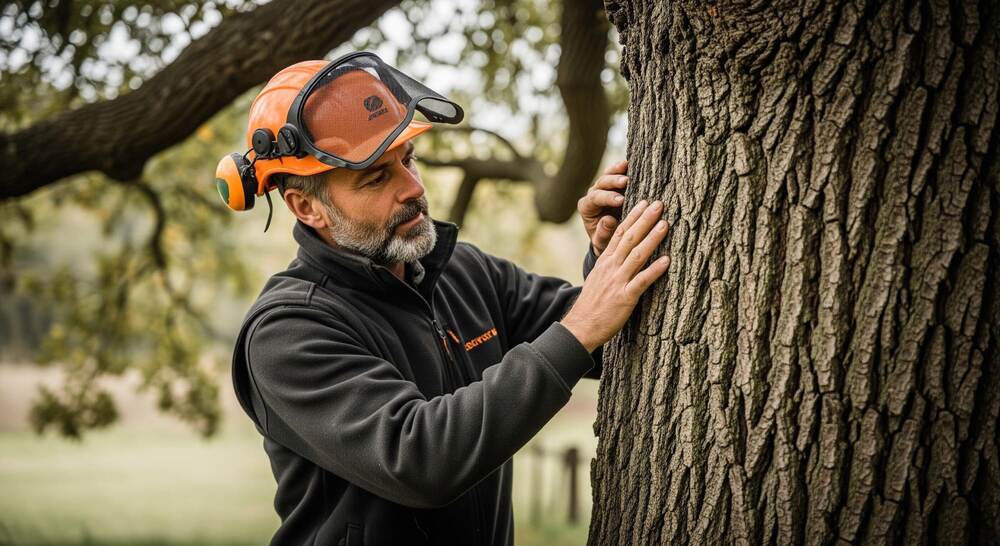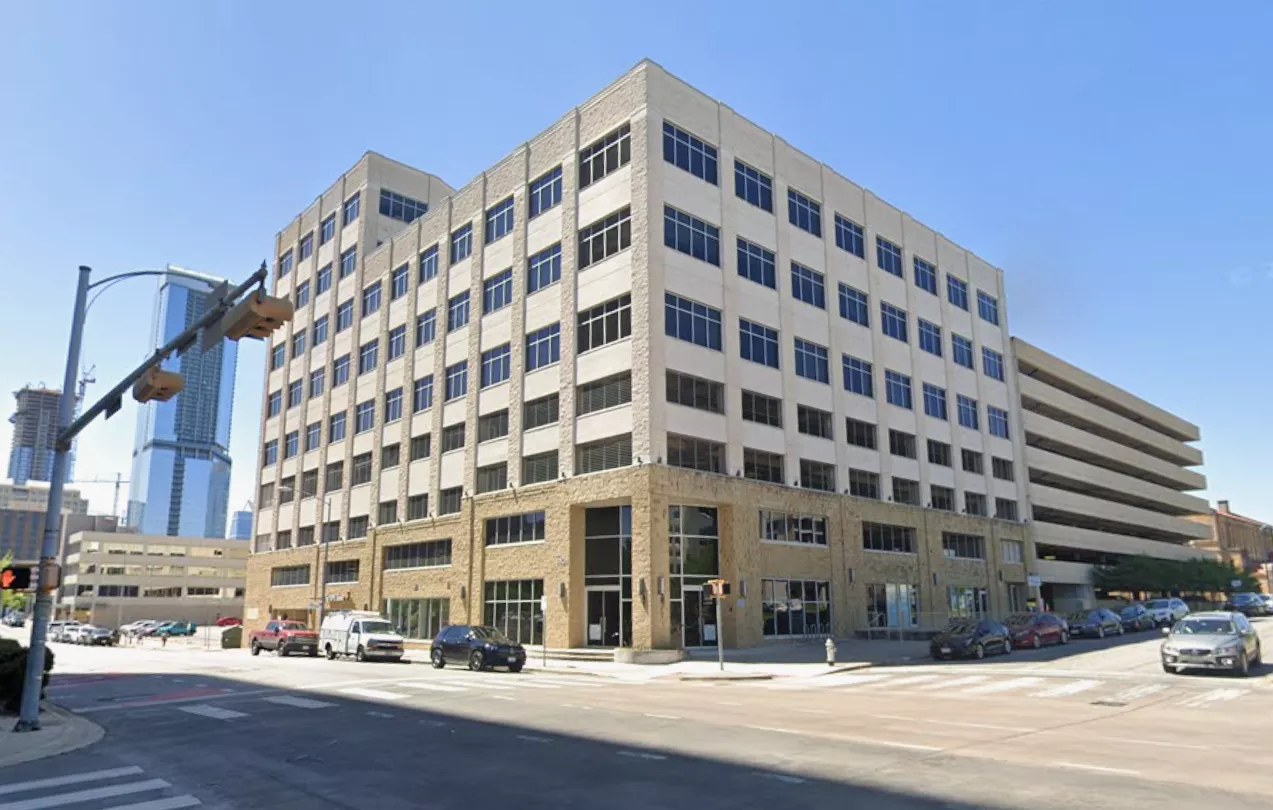Beyond the Basics: Our Full Set of Tree Care Credentials
While ISA Certification is a core qualification, it’s only the beginning of what we offer. Happy Tree Service of Austin carries multiple credentials that support advanced diagnosis, risk evaluation, and disease treatment.
Tree Risk Assessment Qualified (TRAQ)
TRAQ is an advanced credential that allows arborists to formally evaluate the likelihood of tree failure and recommend mitigation options. Whether a tree leans after a storm, shows decay in the trunk, or has overextended limbs near a structure, our team uses risk assessment techniques to determine the best course of action.
This training goes beyond visual inspections. It includes load calculations, decay analysis, and site condition evaluation. When we recommend pruning, bracing, or removal, it’s backed by data—not guesswork.
Texas Oak Wilt Qualified
Oak wilt is one of the most serious tree diseases in Texas, and treating it requires specialized training. Happy Tree Service of Austin is proud to have team members who are Texas Oak Wilt Qualified. This designation allows us to accurately identify oak wilt symptoms, recommend treatment, and perform pruning during the safe window to prevent further spread.
We also understand how to coordinate with property owners and neighboring trees to reduce risk across a broader landscape. This disease spreads fast, and having the right qualifications can make the difference between saving a tree and losing an entire canopy.
Tree Services That Require a Certified Arborist
Some tree work can be done by general crews, but many tasks require advanced knowledge to avoid permanent damage or safety hazards. These services should always be overseen by a certified professional.
Pruning and Structural Trimming
Poorly placed cuts, improper timing, or aggressive thinning can seriously weaken a tree. Our certified team provides expert tree trimming Austin and Austin tree prunning services that keep your landscape safe and balanced. Certified arborists are trained to assess tree structure, species-specific pruning needs, and seasonal timing to protect the canopy and reduce stress. We follow ANSI A300 pruning standards and avoid harmful practices like topping or lion-tailing.
Tree Removal and Hazard Assessment
Tree removal is one of the most dangerous types of tree work. Our Austin tree removal services are handled by certified professionals using rigging techniques, structural evaluations, and site planning to ensure removals are done safely. Whether a tree is near power lines, fences, or buildings, our team uses proper equipment and planning to protect both people and property.
Disease Diagnosis and Lab Testing
Many tree problems look similar at first glance—wilting, yellow leaves, or branch dieback could be caused by pests, disease, or environmental stress. Certified arborists know how to distinguish between symptoms and collect tissue or soil samples for lab testing. We work with resources like the Texas A&M Plant Pathology Lab to ensure accurate diagnosis before recommending treatment.
Soil Preparation and Tree Planting
Certified arborists evaluate soil compaction, drainage, and nutrient content before planting. Our tree planting services Austin help ensure new trees establish strong roots and thrive long-term. We also help select the right tree species based on sun exposure, water availability, and long-term growth potential. These steps give your new tree the best chance to establish strong roots and grow safely over time.
What Can Go Wrong With Unqualified Tree Crews
Tree care is not just physical labor—it’s a technical, biological, and safety-sensitive service that should only be performed by trained professionals. Unfortunately, many property owners hire unqualified or uncertified crews based on a lower quote or fast availability. While the appeal of a quick fix is understandable, the long-term consequences can be serious.
Hiring an uncertified tree crew often leads to improper pruning, unsafe removals, misdiagnosed issues, and a complete lack of accountability. These mistakes can cause irreversible damage to your trees, expose you to liability, and cost far more in repairs or replacements later on.
Topping and Over-Pruning That Weakens Trees
One of the most common mistakes made by untrained crews is topping, which involves cutting back large limbs to stubs. This technique destroys a tree’s natural form and invites weak, fast-growing shoots that break easily in storms. Lion-tailing—where all interior branches are removed, leaving only a few leaf clusters at the ends—has a similar effect. Both methods leave the tree structurally compromised and unable to properly photosynthesize, which can shorten its lifespan dramatically.
Certified arborists understand how to prune trees while preserving their strength, form, and energy balance. We follow ANSI A300 pruning standards to protect your tree’s health—not just its appearance.
Improper Removal That Causes Property Damage
Tree removal is one of the most hazardous services in the industry. Untrained crews may underestimate the lean of a tree, miscalculate weight distribution, or lack proper rigging and lifting tools. The result is often catastrophic: broken fences, smashed roofs, damaged driveways, or worse. In tight spaces, safe removal requires planning, teamwork, and a strong understanding of how trees behave when cut.
Our certified crews use controlled removal techniques, guided by structural evaluations and safety protocols. Every cut is deliberate, and every removal is planned to avoid collateral damage.
Misdiagnosis and Wasted Treatments
Tree symptoms can be misleading. Yellow leaves, early leaf drop, or thinning crowns may be caused by pests, soil deficiencies, root rot, or disease. Unqualified crews often guess at the cause and recommend treatments that don’t work—or make things worse. In cases like oak wilt, this kind of misdiagnosis can result in the loss of valuable trees and increased exposure to surrounding oaks.
Certified arborists are trained to distinguish between overlapping symptoms. We also have access to lab testing through institutions like the Texas A&M Plant Pathology Lab, which allows for precise diagnosis and appropriate treatment.
No Insurance or Accountability
Working with uninsured or uncertified tree crews leaves you exposed to serious risks. If a worker is injured on your property or a falling limb damages your neighbor’s home, you could be held liable. Many uncertified providers operate without general liability or workers’ compensation coverage, and few offer written estimates or warranties.
At Happy Tree Service of Austin, we maintain full insurance coverage and always provide documentation of our credentials. We operate transparently and take responsibility for the work we do—from consultation to cleanup.
How to Confirm You’re Hiring a Certified Arborist

If you’re searching for a tree service provider in Austin, verifying their certification status is an important first step. Here’s how you can protect yourself and ensure your trees are in qualified hands.
Check the ISA Database by Name or ZIP Code
The International Society of Arboriculture maintains a public directory of all active certified arborists. You can search by company name, individual name, or ZIP code to confirm whether your provider is truly certified.
Ask to See Credentials and Insurance Documents
Professional companies will have no problem showing proof of ISA certification and up-to-date insurance. Don’t rely on verbal confirmation or assume credentials based on website language. Ask for documentation—this protects your trees and your property.
Look for Certification on Estimates and Vehicles
Most certified providers display ISA certification logos on estimates, vehicles, and uniforms. This transparency reflects their commitment to quality and ethical service. At Happy Tree Service of Austin, we proudly display our credentials because we want our clients to feel confident in the level of care we deliver.
How We Apply ISA Standards to Every Job
Certification isn’t just a badge—it’s the foundation of how we work. At Happy Tree Service of Austin, we apply ISA standards in every service we provide, from routine pruning to complex removals.
Diagnostic Tools and Lab Testing Partnerships
Our arborists begin with a full evaluation of the tree’s condition. This includes visual inspections, root collar exposure checks, and, when necessary, sample collection for lab testing. We partner with the Texas A&M Plant Pathology Lab to confirm suspected disease and rule out environmental stress factors. This science-based process prevents trial-and-error treatment and leads to better results.
Seasonal Timing and Tree-Specific Planning
Different trees require different care depending on the time of year. We prune oaks only during the safe window from July through January to reduce oak wilt risk. Fruit trees like peaches benefit from winter pruning, while evergreens may require minimal touch-ups in spring or summer. We align every service with the tree’s natural cycle and Central Texas climate trends to support long-term health.
Safety Protocols From Start to Finish
Tree care often involves dangerous heights, heavy limbs, and nearby structures. Our crews follow strict safety protocols at every stage of service. We use protective equipment, spotters, and controlled lowering systems to keep your home, landscaping, and our team safe. Whether we’re removing a hazardous tree or trimming limbs over a driveway, safety comes first.
Why Certified Arborists Matter for HOAs, Businesses, and Large Properties
Commercial properties and shared residential landscapes carry added complexity. Our Austin commercial tree services cover everything from planting to removals, risk assessments, and tree cabling services for structural support. Large trees near walkways, parking lots, and buildings require professional oversight to avoid legal, structural, and safety risks. Certified arborists bring a level of expertise and planning that supports responsible management.
Tree Risk Assessments That Reduce Liability
We conduct formal tree risk assessments for HOAs, apartment complexes, and business campuses. These evaluations identify trees at risk of failure and provide actionable plans for mitigation. By proactively addressing hazards, you reduce the likelihood of accidents and improve the overall safety of your property.
Reliable Scheduling and Professional Documentation
Our commercial clients rely on us for predictable service. We show up when scheduled, provide detailed written estimates, and document all completed work. This helps property managers stay compliant with city regulations and gives stakeholders confidence in their landscape maintenance plans.
Long-Term Health Plans for Large Landscapes
Certified care isn’t just about emergencies—it’s about keeping your trees healthy year after year. We offer maintenance plans that include seasonal pruning, soil assessments, and disease monitoring. With regular evaluations and seasonal tree care in Austin, your trees become more resilient, easier to maintain, and better integrated into your property’s overall design.
Talk to an ISA Certified Arborist Near You in Austin Today., Happy Tree Provides 30+ years of Expertise in the Field of Tree Care
Choosing the right tree care provider affects more than just how your trees look—it affects how they grow, how long they live, and how safe your property stays. At Happy Tree Service of Austin, we bring ISA Certified Arborists, deep regional experience, and a client-first mindset to every project.
Whether you need pruning, removal, planting, or diagnostic help, our certified team provides tree healthcare by certified arborist Austin to deliver trusted results for every property. We combine science, safety, and service to protect your trees and support your property goals.
Call us today at 512-599-9948 or reach out online to speak with a certified arborist. We’re proud to serve homeowners, HOAs, and businesses throughout the Austin area with tree care that meets the highest standard. Let us show you the difference certified care can make.
![]() 300+ Google Reviews
300+ Google Reviews

 Why Austin’s Climate Demands Certified Tree Experts
Why Austin’s Climate Demands Certified Tree Experts




